Avro Vulcan Videos
|
Loading...
|
|
Avro Vulcan
Vulcan
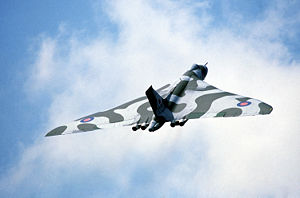
Picture - A Vulcan B.2 of the RAF
Role: Strategic bomber
National origin: United Kingdom
Manufacturer: Avro
First flight: 30 August 1952
Introduction: 1956
Retired: March 1984
Status: Retired from service
Primary user: Royal Air Force
Produced: 1956-1965
Number built: 136 (including prototypes)
Unit cost: Ł750,000 (1956)
The Avro Vulcan, sometimes referred to as the Hawker Siddeley Vulcan, is a delta wing subsonic jet strategic bomber that was operated by the Royal Air Force (RAF) from 1953 until 1984. It was developed in response to a specification released by the Air Ministry. At the time, both jet engines and delta wings were considered cutting-edge and relatively unexplored; thus, the small-scale Avro 707 was produced to test the principles of the design. In flight, the Vulcan was an agile aircraft for its size.
The Vulcan B.1 was first delivered to the RAF in 1956. In service, the Vulcan was armed with nuclear weapons and was a part of the RAF's V bomber force, the United Kingdom's airborne deterrent against aggression from other powers such as the Soviet Union during the Cold War. In addition to an extensive electronic countermeasures suite, the Vulcan had a small radar cross-section, aiding its deterrent role by evading detection and therefore increasing the likelihood of penetrating Soviet airspace and deploying its weapons load successfully. A second batch of aircraft, the B.2, was produced with new features, including a larger wing and greater fuel capacity, along with more advanced electronics and radar systems.
The B.2s were adapted into several other variants, the B.2A carrying the Blue Steel missile, the B.2 (MRR) for Marine Radar Reconnaissance use, and the K.2 tanker for air-to-air refuelling. The Vulcan was also used in the secondary role of conventional bombing near the end of its service life in the 1982 Falklands War against Argentina during Operation Black Buck. One example, XH558, was recently restored for use in display flights and commemoration of the employment of the aircraft in the Falklands conflict.
Development
Design work began at A. V. Roe in 1947 under Roy Chadwick, however, the delta wing design built upon the wartime work of Professor Alexander Lippisch, and the first design studies featured a radical tailless delta wing design. The Air Ministry specification B.35/46 required a bomber with a top speed of 575 mph (925 km/h), an operating ceiling of 50,000 ft (15,000 m), a range of 3,452 miles (5,556 km) and a bomb load of 10,000 lb (4,500 kg); intended to carry out delivery of Britain's nuclear-armed gravity bombs to strategic targets within Soviet territory. Design work also began at Vickers and Handley Page. All three designs were approved - aircraft that would become the Valiant, the Victor, and the Avro Vulcan.
The Type 698 as first envisaged by Chadwick, and upon his death in the crash of the Avro Tudor 2 prototype on 23 August 1947, later refined by his successor, Stuart Davies in March 1949, was a more conventional delta wing design initially with tail surfaces at the ends of the wing and finally with a "full" tail unit. Avro felt this would be able to give the required combination of large wing area and sweepback to offset the transonic effects and a thick wing root to embed the engines. The thick wing gave considerable space for the engines and made allowances for future larger models to be installed. Wingtip rudders provided the control instead of the traditional rear fuselage and tail, which were unnecessary on this design. This design was reworked multiple times to reduce weight, a restriction which was later loosened, and became more conventional, adopting a centre fuselage with four paired engines and a tail.
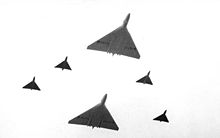
Picture - The prototype Vulcans (VX777 front, VX770 rear) with four Avro 707s at Farnborough in September 1953
As the delta wing was an unknown quantity, Avro began scale prototype testing in 1948 with a series of single-seater Avro 707 "proof-of-concept" aircraft. Despite the crash of the first 707 prototype on 30 September 1949, work continued and eventually four additional 707s were built to test low-speed as well as high-speed characteristics of the delta wing design.
The first full-scale prototype Type 698 made its maiden flight piloted by Roly Falk on 30 August 1952. Since the Bristol Olympus engines were not ready, the aircraft was launched with the Rolls-Royce Avon. Before the Olympus engines were ready, the Avons were replaced by Armstrong Siddeley Sapphires. The Vulcan name was not chosen until 1952, after the Valiant had already been named.
Two prototypes were built and subsequently modified for development. Both flew with a straight leading edge, which was then modified to have a kink further out towards the wingtip; this was to remove the occurrence of high frequency buffeting during flight. The production Vulcan bomber in service was fitted with a delta wing, but these were not pure delta wings for reason of better flying characteristics, and successive variants saw the wing altered and expanded again.
Avro chief test pilot, retired Wing Commander Roly Falk, demonstrated the aircraft's high performance and agility at the 1955 Farnborough Airshow. While flying the second production Vulcan, XA890, he performed an upward barrel roll shortly following takeoff.
Design
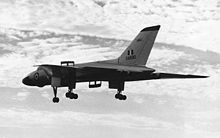
Picture - Vulcan B.1 XA890 in early silver scheme landing at Farnborough in September 1955 after Roly Falk's "aerobatic" display
The Vulcan normally operated with a crew of five: two pilots, two navigators and an Air Electronics Operator (AEO), with the AEO responsible for all electrical equipment in a role similar to that of flight engineer on earlier propeller aircraft. Only the pilot and co-pilot were provided with ejection seats; the fact that the rear crew were not provided ejection seats led to considerable criticism. There have been several instances of the pilot and co-pilot ejecting in an emergency and the rear crew being killed because there was not enough time for them to bail out.
Despite its large size, it had a relatively small radar cross-section (RCS) as it had a fortuitously stealthy shape apart from the tail fin; at certain angles, it would vanish from the radar altogether. The Vulcan used entirely powered control surfaces; this allowed a joystick to be used instead of a larger yoke. This system provided a synthetic controls “feel”; flying conditions were fed back to pilot flying as a proportional resistance to his control inputs based upon the aircraft's dynamic flight configuration.
The main navigation and bombing aid on the Vulcan was the Navigation and Bombing System, (NBS) the main element being a H2S radar with a nose-mounted scanner. In order to assist in low level flying, which became a common bomber tactic as Soviet SAM capabilities and numbers grew in the late 1950s, the Vulcans were outfitted with Terrain Following Radar (TFR) in 1966. The TFR used was created for the American General Dynamics F-111 Aardvark. The Red Steer tail-warning radar was also amongst the tools available to the AEO, increasing the likelihood of spotting an enemy fighter and effectively using chaff and flares to negate missile attacks. The extensive electronic countermeasures (ECM) suite installed on the Vulcans kept them a viable option, capable of successfully penetrating Soviet air defenses if need be, throughout the 1960s.
Electrical power was DC supplied from generators on each engine. Backup power was available from batteries if the generators failed; however, these had little capacity in event of power loss. The power systems were revised for the B.2, switching from DC to AC, the inclusion of a Ram Air Turbine (RAT) that would operate at higher altitude, and an Airborne Auxiliary Power Unit (AAPU) which could be started once the aircraft had reached a lower altitude of 30,000 ft (9,100 m) or less.
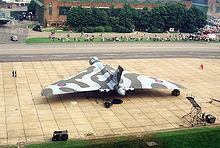
Picture - Aerial view of a Vulcan B.2 in late RAF markings on static display at RAF Mildenhall
Operational history
Introduction
In September 1956, the RAF received its first Vulcan B.1, XA897, which immediately went on a round-the-world tour; this was done due to a great emphasis placed upon the provision of goodwill visits and tours abroad during the early years of Vulcan operation, as they were seen as highly effective propaganda; many Vulcans were utilised in this role. Misfortune struck on 1 October 1956, however; while landing at London Heathrow Airport at the completion of the world tour, XA897 was destroyed in a fatal accident.
By September 1957, several Vulcans had been handed over to No.32 Squadron, the first operational Squadron to use the bomber. A total of 134 production Vulcans were manufactured, 45 to the B.1 design and 89 were B.2 models, the last being delivered to the RAF in January 1965.
In order to increase the mission range and flight time for Vulcan operations, in-flight refuelling capabilities were added in 1959 onwards; several Valiant bombers were refurbished as tankers to refuel the Vulcans. Continuous airborne patrols proved untenable, however, and the refuelling mechanisms across the Vulcan fleet fell into disuse in the 1960s.
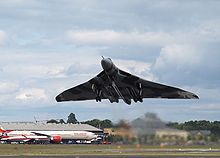
Picture - XH558 taking off; Farnborough international air show 2008
Vulcans frequently visited the United States during the 1960s and 1970s to participate in air shows and static displays, as well as to participate in the Strategic Air Command's Annual Bombing and Navigation Competition at such locations as Barksdale AFB, Louisiana and the former McCoy AFB, Florida, with the RAF crews representing Bomber Command and later Strike Command. Vulcans also took part in the 1960, 1961, and 1962 Operation Skyshield exercises, in which NORAD defences were tested against possible Soviet air attack, the Vulcans simulating Soviet fighter/bomber attacks against New York, Chicago and Washington. The results of the tests were classified until 1997.
Nuclear deterrent
As part of Britain's independent nuclear deterrent, the Vulcan initially carried Britain's first nuclear weapon, the Blue Danube gravity bomb. Blue Danube was a low-kiloton yield fission bomb designed before the United States detonated the first hydrogen bomb. The British then embarked on their own hydrogen bomb programme, and to bridge the gap until these were ready the V-bombers were equipped with an Interim Megaton Weapon based on the Blue Danube casing and Green Grass, a large pure-fission warhead of 400 kt (1.7 PJ) yield. This bomb was known as Violet Club. Only five were deployed before a better weapon was introduced as Yellow Sun Mk.1.
A later model, Yellow Sun Mk 2, was fitted with Red Snow, a British-built variant of the U.S. Mk-28 warhead. Yellow Sun Mk 2 was the first British thermonuclear weapon to be deployed, and was carried on both the Vulcan and Handley Page Victor. Only the Valiant carried U.S. thermonuclear bombs assigned to NATO under the dual-key arrangements. Red Beard (a smaller, lighter low-kiloton yield) bomb was pre-positioned in Cyprus and Singapore for use by Vulcan and Victor bombers, and from 1962, 26 Vulcan B.2As and the Victor bombers were armed with the Blue Steel missile, a rocket-powered stand-off bomb, which was also armed with the 1.1 Mt (4.6 PJ) yield Red Snow warhead.
Operationally, RAF Bomber Command and the US Strategic Air Command cooperated together in the Single Integrated Operational Plan (SIOP) to ensure coverage of all major Soviet targets from 1958, 108 aircraft of the RAF's V-Bombers were assigned targets under SIOP by the end of 1959. From 1962 onwards, two jets in every major RAF base were armed with nuclear weapons and on standby permanently under the principle of Quick Reaction Alert (QRA). Vulcans on QRA standby were to be airborne within four minutes of receiving an alert, as this was identified as the amount of time between warning of a USSR nuclear strike being launched and it arriving in Britain. The closest the Vulcan came to take part in potential nuclear conflict was during the Cuban missile crisis in October 1962, where Bomber Command was moved to Alert Condition 3, an increased state of preparedness from normal operations, however stood down in early November.
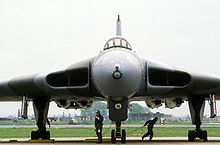
Picture - Royal Air Force Avro Vulcan B.2
The Vulcans were intended to be equipped with the American Skybolt Air Launched Ballistic Missile to replace the Blue Steel, with Vulcan B.2s carrying two Skybolts under the wings; the last 28 B.2s were modified on the production line to fit pylons to carry the Skybolt. Also proposed was a stretched version of the Vulcan, with increased wingspan to carry up to six Skybolts. When the Skybolt missile system was cancelled by U.S. President John F. Kennedy on the recommendation of his Secretary of Defense, Robert McNamara in 1962, Blue Steel was retained. To supplement it until the Royal Navy took on the deterrent role with Polaris submarines, the Vulcan bombers adopted a high-low-high mission profile using a rapidly introduced parachute-retarded "laydown" bomb, WE.177B. After the British Polaris submarines became operational and Blue Steel was taken out of service in 1970, WE.177B continued in use on the Vulcan in a low-level tactical strike role in support of European NATO ground forces. It outlived the Vulcan bombers, being used also on Buccaneer, Panavia Tornado, and Jaguar until retirement in 1998. While not a like-for-like replacement, the multirole Tornado is the successor for the positions filled by the Vulcan following its retirement.
Conventional role
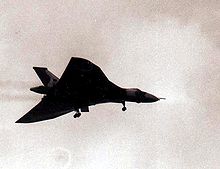
Picture - Vulcan over Ascension Island on 18 May 1982
Although the primary weapon for the aircraft was nuclear, Vulcans could carry up to 21 1,000 lb (454 kg) bombs in a secondary role, and squadrons had been conducting training for conventional bombing and strike roles since the 1960s.
The only combat missions involving the Vulcan took place in 1982 during the Falklands War with Argentina. This was also the only time V-bombers took part in conventional warfare. The Vulcans flew missions knows as the Black Buck raids, 3,889 mi (6,259 km) from Ascension Island to Stanley on the Falklands. The first raid struck on 1 May when a lone Vulcan bomber flew over Port Stanley and dropped bombs across the main airfield. This was quickly followed up by strikes against anti-air installations made by carrier-based British Aerospace Sea Harriers.
In total, there were three missions to bomb the airfield at Stanley and two to attack Argentine radar installations with missiles, while two missions were cancelled. Victor aircraft were used for air-to-air refuelling in a complex scheme, and approximately 1.1 million gal (5 million L) of jet fuel were used in each mission. The Vulcan's ECM system was effective at jamming Argentine radars, greatly reducing the likelihood of British airborne elements coming under effective fire.
Five Vulcans were selected for the operation; their bomb bays were modified, the flight refuelling system that had long been out of use was reinstated, the electronics updated, and new wing pylons fitted to carry an ECM pod and Shrike anti-radar missiles at wing hardpoint locations originally installed for carrying Skybolt missiles. The engineering work began on 9 April 1982 with the first mission on 30 April-1 May. At the time, these missions held the record for the world's longest-distance raids; reaching the islands required extensive in-flight refuelling operations.
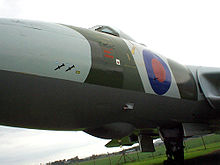
Picture - Avro Vulcan from Operation Black Buck at the National Museum of Flight, showing mission markings
Maritime radar reconnaissance
On 1 November 1973, the first of nine B.2 (MRR) aircraft was delivered to No. 27 Squadron at RAF Scampton, reformed for its main role of maritime radar reconnaissance. The main external visual difference was the presence of a gloss paint finish, with a light grey undersurface, which was made due to the secondary role of air sampling. Only five of the B.2 (MRR)s were capable of air sampling, and these aircraft were distinguished by the additional hardpoints outside the Skybolt points.
Aerial refuelling role
After the end of the Falklands War in 1982, the Vulcan was due to be withdrawn from RAF service that year. However, the Falklands campaign had consumed much of the airframe fatigue life of the RAF's Victor Tankers. While Vickers VC-10 and Lockheed TriStar tankers would be ordered as a result of lessons learned from the conflict, six Vulcan B.2s were converted to a tanker configuration as a stopgap measure. The Vulcan Tanker conversion was accomplished by removing the jammers from the ECM bay in the tail of the aircraft, and replacing them with a single Hose Drum Unit (HDU).
The go-ahead for converting the six aircraft was given on 4 May 1982. Just fifty days after being ordered, the first Vulcan Tanker, XH561, was delivered to RAF Waddington. The additional fuel load in the Vulcan K.2 Air Tanker was carried in three large tanks fitted in the bomb bay, giving a total fuel capacity of 100,000 lb (45,000 kg). The Vulcan K.2s were operated by No.50 Squadron, along with three Vulcan B-2s, in support of UK air defense activities.
Engine test beds
The first Vulcan prototype, VX770, was also the first Vulcan to serve as an engine test bed. Initially refitted with Armstrong Siddeley Sapphires, four 15,000 lbf (67 kN) Rolls-Royce Conway R.Co.7 were later installed. It flew with the Conways, the first turbofans in the world, from 1957-8 until its fatal crash. Its place was taken by Vulcan B.1 XA902, which was powered by the R.Co.11 variant. In 1961 the two inner Conways were replaced with Rolls-Royce Speys, flying for the first time on 12 October 1961.
XA894 flew with five Olympus engines, the standard four plus an underbelly supersonic Olympus 320 fed from a bifurcated intake starting just aft of the wing leading edge and inboard of the main intakes, in a mock-up of the BAC TSR-2 installation. This aircraft was destroyed on a fire on the ground on 3 December 1962. Another Vulcan, B.1 XA903, was converted to a similar layout. The Olympus test engine mounted was a 35,080 lbf (156.0 kN) Olympus 593, the type later used on the Concorde, mounted underbelly in a mockup of a single Concorde nacelle. The first flight was on 1 October 1966 and testing continued through to June 1971.
In April 1973, XA903 flew with an underbelly Rolls-Royce RB.199 turbofan destined for the Panavia Tornado. The RB.199 engine included both the reheat and thrust reverser functions.
Variants
B.1 The initial production aircraft, with the straight wing leading edge, with wide undercarriage track and four overwing airbrakes. Early examples finished in silver, later changed to "anti-flash" white. Unlike the B.2 production batch, the B.1s did not undergo extensive wing strengthening for low-level flying.
B.1A The B.1 with an Electronic Countermeasures (ECM) system in a new larger tail cone.
B.2 Developed version of the B.1. Larger, thinner wing than the B.1 and fitted with Olympus 201 or 301 engines. Terrain-following radar in nosecone and passive radar warning in tail fin giving it a square top from mid-1970s. Uprated electrics with Airborne Auxiliary Power Unit and emergency Ram Turbine generator.
B.2A Also known as B.2BS. B.2 with Olympus 301 engines to carry Blue Steel in recessed bomb doors.
B.2 (MRR) Nine B.2 converted to Maritime Radar Reconnaissance. Five aircraft further modified for Air Sampling Role. Distinctive gloss finish with light grey underside.
K.2 Six B.2 converted for air-to-air refuelling with Mark 17 hose drum mounted semi-recessed in tail cone. It was fitted with three bomb-bay drum tanks, and was the only mark of Vulcan that could jettison fuel in an emergency.
Operators
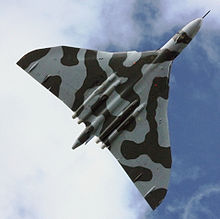
Picture - The Vulcan to the Sky Trust's Avro Vulcan XH558
United Kingdom
Royal Air Force
No. 9 Squadron RAF (Operated the B.2 from 1962 to 1982)
No. 12 Squadron RAF (Operated the B.2 from 1962 to 1967)
No. 27 Squadron RAF (Operated the B.2 from 1961 to 1972 and the B.2 (MRR) from 1973 to 1982)
No. 35 Squadron RAF (Operated the B.2 from 1962 to 1982)
No. 44 Squadron RAF (Operated the B.1 from 1960 to 1967 and the B.2 from 1966 to 1982)
No. 50 Squadron RAF (Operated the B.1 from 1961 to 1966, the B.2 from 1966 to 1984 and the B.2 (K) from 1982 to 1984)
No. 83 Squadron RAF (the first Vulcan squadron operated the B.1 from 1957 to 1960 and the B.2 from 1960 to 1969)
No. 101 Squadron RAF (Operated the B.1 from 1957 to 1967 and the B.2 from 1967 to 1982)
No. 617 Squadron RAF (Operated the B.1 from 1958 to 1961 and the B.2 from 1961 to 1981)
No. 230 Operational Conversion Unit RAF
Vulcan To The Sky Trust (flying XH558)
Accidents and incidents
On 1 October 1956, Vulcan B.1 XA897 crashed at London Heathrow Airport after an approach in bad weather, striking the ground 700 yd (640 m) short of the runway just as engine power was applied. The impact probably broke the drag links on the main undercarriage, allowing the undercarriage to be forced backwards and damage the trailing edge of the wing. After the initial impact, the aircraft rose back in the air. The pilot, Squadron Leader D. R. Howard, and co-pilot Air Marshal Sir Harry Broadhurst both ejected. The aircraft then hit the ground and broke up. Howard and Broadhurst survived but the other four occupants, including Howard’s usual co-pilot, were killed. XA897 was the first Vulcan to be delivered to the RAF. AOC-in-C Bomber Command, Air Marshal Broadhurst, had taken the aircraft with a full Vulcan crew of four and an Avro technician on a round-the-world tour. At the conclusion of the tour, Broadhurst was to land at Heathrow Airport in front of the assembled aviation media. RAF aircraft were not equipped to use the Instrument Landing System installed at Heathrow and other civil airports so a Ground-controlled approach was carried out.
In 1957, a Vulcan B.1 XA892 attached to the Aeroplane and Armament Experimental Establishment (A&AEE) at Boscombe Down for acceptance testing was unintentionally flown to an Indicated Mach Number (IMN) above 1.04, alarming the crew that it had reached supersonic speed. The aircraft commander, Flt Lt Milt Cottee (RAAF) and co-pilot Flt Lt Ray Bray (RAF) were tasked to fly at 478 mph (769 km/h) and 0.98 IMN, to take the aircraft to a load factor of 3 g. The Vulcan was climbed to 35,000 ft (11,000 m) and then dived with the intention of reaching the target speed at 27,000 ft (8,200 m). Approaching the target altitude, the crew closed the throttles and were applying full up-elevator, the aircraft continued to pitch nose-down. Flt Lt Cottee contemplated pushing forward to go inverted and then rolling upright; instead, he opened the speed brakes even though the airspeed was above their maximum operating speed. The speed brakes were not damaged and succeeded in reducing the Mach number. The aircraft came back past the vertical at about 18,000 ft (5,500 m) and regained level flight at 8,000 ft (2,400 m). There was no report of a sonic boom in the vicinity; as such, it is unlikely a true Mach Number of 1.0 was reached. (At Mach 1.0, the Vulcan had position error of about 0.07.) After the flight a rear bulkhead was found to be deformed.
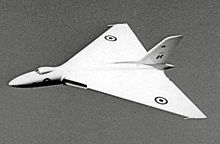
Picture - The prototype Vulcan VX770 in 1954 when powered by Sapphires but retaining the original "pure delta" wing shape
On 20 September 1958, a Rolls-Royce test pilot was authorised to fly VX770 on an engine performance sortie with a fly past at RAF Syerston Battle of Britain "At Home" display. The Vulcan flew along the main runway then started a roll to starboard and climbed slightly. During this roll the starboard wing disintegrated, resulting in a collapse of the main spar and wing structure. The Vulcan went into a dive with the starboard wing on fire and struck the ground. Three occupants of a controllers' caravan were killed by debris, all four of the Vulcan crew were also killed. The cause may have been pilot error; analysis of amateur cine film suggested the aircraft had flown over the airfield at 472-483 miles per hour (760-777 km/h) instead of the briefed 288-345 miles per hour (463-555 km/h); it had also descended to a height of 65-70 ft (20-21 m) instead of 200-300 ft (61-91 m). Rolling the Vulcan to starboard while flying at this speed imposed a load or stress of 2-3 g; it should have remained below 1.25 g. The VX770 was a prototype with construction and materials not to production standard, which was the primary reason for imposing low flight performance limits. Avro Chief Test Pilot Tony Blackman notes that when Avro display pilots carried out aerobatics, the displays were followed by a careful but little-known inspection of the inside of the wing's leading edge. Rolls-Royce pilots also carried out aerobatics, but Blackman speculates that Rolls-Royce did not know of the inspections, and VX770 may have already been severely structurally damaged.
On 24 October 1958, Vulcan B.1 XA908 of No. 83 Squadron crashed into the residential neighbourhood of Grosse Pointe Park on the East side of Detroit, Michigan, USA after a complete electrical systems failure. The failure occurred at around 30,000 ft (9,100 m) and the backup system should have provided 20 minutes of emergency power to allow the aircraft to divert to Kellogg Airfield, at Battle Creek, Michigan. Due to a short circuit in the service busbar, backup power only lasted three minutes before expiring and locking the aircraft controls. XA908 then went into a dive of between 60-70° before it crashed, leaving a 40-ft (13 m) crater in the ground, which was later excavated to 70 ft (21 m) deep in an unsuccessful attempt to find the cockpit of the aircraft. All six crew members were killed, including the co-pilot, who had ejected. The co-pilot’s ejector seat was found in Lake St Clair, but his body was never recovered. There were no ground fatalities, and only one person on the ground required hospitalization, though property damage was extensive.
On 24 July 1959, Vulcan B.1 XA891 crashed due to an electrical failure during an engine test. The aircraft commander was Avro Chief Test Pilot Jimmy Harrison. Shortly after take-off the crew observed generator warning lights and loss of busbar voltage. The aircraft commander climbed XA891 to 14,000 ft (4,300 m) and steered a course away from the airfield and populated areas while the AEO attempted to solve the problem. When it became clear that control of the aircraft would not be regained the aircraft commander instructed the crew in the rear compartment to exit the aircraft, and the co-pilot to eject. The aircraft commander then also ejected. All the crew survived, making them the first complete crew to escape successfully from a Vulcan. The aircraft crashed near Kingston upon Hull.
On 12 December 1963, Vulcan B.1A XH477 of No. 50 Squadron crashed in Scotland during an exercise at low level (not less than 1,000 ft (300 m) above ground.) XH477 had struck the ground while climbing slightly, and it was assumed it crashed due to poor visibility.
On 11 May 1964, Vulcan B.2 XH535 crashed during a low speed demonstration. The test pilot was demonstrating a very low speed and high rate of descent when the aircraft began to spin. The landing parachute was deployed and the spin stopped briefly, but the aircraft then began to spin again. At around 2,500 ft (760 m) the aircraft commander instructed the crew to abandon the aircraft. The aircraft commander and co-pilot ejected successfully but none of the crew in the rear compartment did so, presumably due to the g forces in the spin.
On 16 July 1964, Vulcan B.1A XA909 crashed in Anglesey after a midair explosion, causing both No. 3 and No. 4 engines were shut down. The explosion was caused by failure of a bearing in No. 4 engine. The starboard wing was extensively damaged, the pilot had insufficient aileron power, and both airspeed indications were highly inaccurate. The whole crew successfully abandoned XA909 and were found within a few minutes and rescued.
On 7 October 1964, Vulcan B.2 XM601 crashed during overshoot from an asymmetric power practice approach at Coningsby. The copilot had executed the asymmetric power approach with two engines producing thrust and two at idle. He was being checked by the Squadron Commander, who was unfamiliar with the aircraft. When he commenced the overshoot the copilot moved all the throttles to full power. The engines that had been producing power reached full power more quickly than the engines at idle and the resultant asymmetric thrust exceeded the available rudder authority, causing the aircraft to spin and crash. All the crew perished. Sqn Ldr Ron Dick, later Air Cdre, said it had happened to him once where the horizon passed rapidly across his field of view; the only recovery was to retard all 4 engines to idle and then increase them together.
On 25 May 1965, Vulcan B.2 XM576 crash-landed at Scampton, causing it be written off within a year of delivery.
On 11 February 1966, Vulcan B.2 XH536 of the Cottesmore Wing crashed in the Brecon Beacons during a low level exercise. The aircraft struck the ground at 1,910 ft (580 m) near the summit of Fan Bwlch Chwyth 1,978 ft (603 m), 20 mi (32 km) northeast of Swansea. All crew members died. Hilltops at the time were snow-covered and cloud extended down to 1,400 ft (430 m).
On 6 April 1967, Avro Vulcan B.2 XL385 burnt out on the runway at RAF Scampton during its takeoff run. It was enroute for Goose Bay. All crew survived. The accident was caused by failure of a compressor blade on the inner port engine. The aircraft was carrying a dummy Blue Steel missile, and fire was a difficult one for the fire crews to deal with as it involved a running fuel fire and high cross winds. Subsequently, the aircraft was completely engulfed in flames and totally destroyed; only the nose of the aircraft survived.
On 7 January 1971, Vulcan B.2 XM610 of No.44 Squadron crashed after fatigue failure of a blade in the No. 1 engine that damaged the fuel system and led to an engine fire. The crew abandoned the aircraft safely, and the aircraft crashed harmlessly in Wingate.
On 14 October 1975, Vulcan B.2 XM645 of No.9 Squadron out of RAF Waddington lost its left undercarriage and damaged the airframe when it undershot the runway at Luqa airport in Malta. The pilot decided to do a circuit to crash land on runway 24 after it was covered with fire prevention foam. As the aircraft was turning inbound for the landing, it broke up in mid-air over the village of Zabbar, killing five of its seven crew members. Only the pilot and co-pilot escaped, using their ejection seats. Large pieces of the aircraft fell on the village. One woman (Vincenza Zammit, age 48), who was shopping in a street was hit by an electric cable and killed instantly. Some 20 others were injured.
On 12 August 1978, Vulcan B.2 XL390 of No. 617 Squadron crashed during an air display at Naval Air Station Glenview, Illinois in the United States. The accident sequence began at about 400 ft (120 m) after a possible stall during a . The Vulcan crashed into a landfill just north of the base and all crew members aboard perished.
Survivors
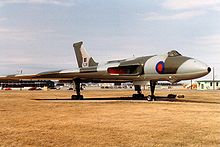
Picture - Avro Vulcan XL361 on display at CFB Goose Bay in 1988
XJ823 Vulcan B.2A - Solway Aviation Museum, Carlisle, Cumbria, England.
XJ824 Vulcan B.2A - Imperial War Museum, Duxford Aerodrome, England.
XL318 Vulcan B.2 - Royal Air Force Museum London, Hendon, England.
XL319 Vulcan B.2 - North East Aircraft Museum, Sunderland, England.
XL360 Vulcan B.2 - Midland Air Museum, Coventry, England.
XL361 Vulcan B.2 - CFB Goose Bay (Happy Valley), Labrador, Canada
XL426 Vulcan B.2 (G-VJET) preserved in taxiable condition at Southend Airport, England.
XM573 Vulcan B.2 - Strategic Air and Space Museum - relocated from Offutt AFB to a site near Ashland, Nebraska, United States.
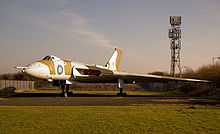
Picture - Avro Vulcan XL319 on display at North East Aircraft Museum
XM575 Vulcan B.2A - East Midlands Airport Aeropark, England.Restoration to flight of Vulcan XH558
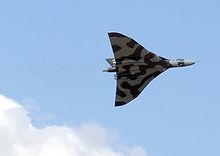
Picture - XH558 performs its first post-restoration public display on 5 July 2008
The last airworthy Vulcan (XH558) has been restored to flying condition by the "Vulcan to the Sky Trust" after years of effort and fundraising. The first post-restoration flight, which lasted 34 minutes, took place on 18 October 2007.
Being the sole airworthy Vulcan, the aircraft's airworthiness status was in peril as maintenance funding was in need before the end of February, 2010. At the last moment an anonymous benefactor presented Ł458,000 to the foundation, ensuring its airworthiness for both its 50th birthday and the prospect of a flight performance for the 2012 Summer Olympic Games opening ceremony in London.
Specifications
Specifications (Vulcan B.1)
Data from Polmar, Laming
General characteristics
Crew: 5 (pilot, co-pilot, AEO, Navigator Radar, Navigator Plotter)
Length: 97 ft 1 in (29.59 m)
Wingspan: 99 ft 5 in (30.3 m)
Height: 26 ft 6 in (8.0 m)
Wing area: 3554 ft˛ (330.2 m˛)
Empty weight: 83,573 lb (including crew) (37,144 kg)
Max takeoff weight: 170,000 lb (77,111 kg)
Powerplant: 4x— Bristol Olympus 101, or 102 or 104 turbojet, 11,000 lbf (49 kN) each
Performance
Maximum speed: Mach 0.96 (607 mph (1,040 km/h)) at altitude
Cruise speed: Mach 0.86 (567 miles per hour (912 km/h)) at 45,000 ft
Range: 2,607 mi (4,171 km)
Service ceiling: 55,000 ft (17,000 m)
Thrust/weight: 0.31
Armament
21 x 1,000 pounds (454 kg) of conventional bombs
1 x Blue Danube nuclear gravity bomb
1 x Violet Club 400-kiloton nuclear gravity bomb
1 x Yellow Sun Mk.1 400-kiloton nuclear gravity bomb
1 x Yellow Sun Mk 2 400-kiloton nuclear gravity bomb
1 x Red Beard nuclear gravity bomb
1 x Blue Steel rocket-propelled 1.1 megaton nuclear stand-off missile
Comparison of variants
Notable appearances in media
V-Bomber Dispersal Bases
Comparable aircraft
Boeing B-47 Stratojet
Handley Page Victor
Tupolev Tu-16/Xian H-6
Vickers Valiant
Citations
Bibliography
Arnold, Lorna. Britain And The H-Bomb. Basingstoke, Hampshire, UK: Palgrave Macmillan, 2001. ISBN 0-333-94742-8.
Austin, Steve. "Workhorse (V-Bombers: Test-bed Vulcan)." FlyPast, No. 335, June 2009, pp. 108-113.
Blackman, Tony. Vulcan Test Pilot: My Experiences in the Cockpit of a Cold War Icon. London: Grub Street, 2007. ISBN 9781904943884.
Braybrook, Roy. "Battle for the Falklands: Air Forces." Oxford, UK: Osprey Publishing, 1982. ISBN 0-850-45493-X.
Brookes, Andrew and Chris Davey. Vulcan Units of The Cold War (Osprey Combat Aircraft: 72). Oxford, UK: Osprey Publishing, 2009. ISBN 978-1846032974.
Bull, Stephen. Encyclopedia of Military Technology And Innovation. Santa Barbara, CA: Greenwood Publishing Group, 2004. ISBN 9781573565578.
Buttler, Tony. "Avro Type 698 Vulcan (Database)." Aeroplane, Vol. 35, No. 4, Issue No. 408, April 2007.
Chesnau, Roger and Ray Rimell. Avro Vulcan B Mk 2 (Aeroguide 29). Ringshall, Suffolk, UK: Ad Hoc Publications, 2003. ISBN 0-946958-39-4.
Darling, Kev. Avro Vulcan, Part One (RAF Illustrated). Vale of Glamorgan Wales, UK: Big Bird Aviation Publication, 2007. ISBN 978-1847992376.
Dodds, Colin. "Flying the Tin Triangle." Aeroplane, Vol. 35, No. 4, Issue No. 408, April 2007.
Fildes, David. "Buck Rogers in the 20th Century: The Origins of the Vulcan." Aeroplane, Vol. 36, No. 3, Issue No. 419, March 2008.
Frawley, Gerard. The International Directory of Military Aircraft, 2002-2003. Fyshwick, ACT, Australia: Aerospace Publications, 2002. ISBN 1-875671-55-2.
Halpenny, Bruce Barrymore. Avro Vulcan: The History and Development of a Classic Jet. Barnsley, South Yorkshire, UK: Pen & Sword Aviation, 2006. ISBN 1-84415-426-2.
Hearn, Chester G. Carriers in Combat: The Air War at Sea. London: Stackpole Books, 2007. ISBN 0-811-73398-X.
Holmes, Harry. Avro: The History of an Aircraft Company. Wiltshire, UK: Crowood Press, 2004. ISBN 1-86126-651-0.
Humphrey, Wynn. RAF Strategic Nuclear Deterrent Forces: Origins, Roles and Deployment 1946-1969. London: The Stationery Office, 1994. ISBN 0-11-772778-4.
Jackson, A. J. Avro Aircraft Since 1908, 2nd Edition. London: Putnam Aeronautical Books, 1990. ISBN 0-85177-834-8.
Jackson, Robert. Combat Aircraft Prototypes since 1945. New York: Arco/Prentice Hall Press, 1986. ISBN 0-671-61953-5.
Jefford, Wing Commander C.G. MBE,BA,RAF (Ret'd). RAF Squadrons:, A Comprehensive Record of the Movement and Equipment of all RAF Squadrons and their Antecedents since 1912. Shrewsbury, Shropshire, UK: Airlife Publishing, 2001. ISBN 1-84037-141-2.
Jenkins, Dennis R. B-1 Lancer: The Most Complicated Warplane Ever Developed. New York: McGraw-Hill, 1999. ISBN 0-07-134694-5.
Jones, Barry. "Black Buck - The Swansong." Aeroplane, Vol. 35, No. 4, Issue No. 408, April 2007.
Lake, Alan. Flying Units of the RAF: The Ancestry, Formation and Disbandment of all Flying Units since 1912. Shrewsbury, Shropshire, UK: Airlife Publishing, 1999. ISBN 1-84037-086-6.
Laming, Tim. The Vulcan Story: 1952-2002, Second Edition. Enderby, Leicester, UK: Silverdale Books, 2002. ISBN 1-85605-701-1.
McLelland, Tim. The Avro Vulcan: A Complete History. Manchester, UK: Crécy Publishing Limited, 2007. ISBN 978-0-85979-127-4.
Polmar, Norman and Dana Bell. One Hundred Years of World Military Aircraft. Annapolis, MD: Naval Institute Press, 2004. ISBN 1-591-14686-0.
Rowland, White. Vulcan 607: The Epic Story of the Most Remarkable British Air Attack since WWII. London: Bantam Press, 2006. ISBN 0-593-05391-5.
Segell, Glen. Wither or dither: British Aerospace Collaborative Procurement with Europe. London: Glen Segell Publishers, 1997. ISBN 1-901-41403-5.
Vulcan B.Mk.2 Aircrew Manual (AP101B-1902-15). London: Air Ministry, 1984.
Willis, David. "Avro Vulcan survivors." Aeroplane, Vol. 35, No. 4, Issue No. 408, April 2007.
Avro Vulcan Pictures and Avro Vulcan for Sale.
Living Warbirds: The best warbirds DVD series.
Source: WikiPedia